Originally Posted At: https://breakingmuscle.com/feed/rss
Kettlebells are a fantastic tool that had a resurgence in the lifting world over the last 20 years, after well over a century of use around the world. They’re versatile and can be used to get stronger, put on size, improve athletic performance, and even develop iron-clad conditioning.
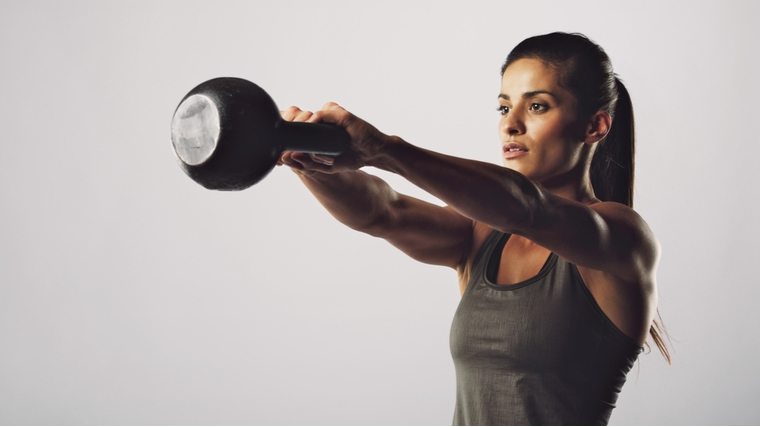
The kettlebell swing is likely the most well-known kettlebell exercise — and for a good reason. It is an excellent movement to improve power; it’s an efficient way to build endurance and burn fat; and it’s a great teaching tool to learn the hip hinge pattern (strengthening the glutes, hamstrings, and lower back). Here’s how to perform a perfect kettlebell swing and everything you need to know about this exercise.
- How to Do the Kettlebell Swing
- Kettlebell Swing Mistakes to Avoid
- Benefits of the Kettlebell Swing
- Muscles Worked by the Kettlebell Swing
- Who Should Do the Kettlebell Swing
- How to Program the Kettlebell Swing
- Kettlebell Swing Variations
- Kettlebell Swing Alternatives
- Frequently Asked Questions
Kettlebell Swing Tutorial Video
Coach Justin Lind shares an extremely detailed explanation and demonstration of the kettlebell swing. Watch the video in its entirety before, or after, reading the full article to see the movement put into action and highlight the details of its performance.
[Related: Why You Should Be Greasing The Groove During Your Workouts]
How to Do the Kettlebell Swing
The kettlebell swing is a dynamic movement that develops lower body power. Because it requires explosive output, you should always pay attention to proper technique to avoid injuries and reap the intended benefits.
Step 1 — Get Into the Starting Stance

Place a kettlebell on the ground and stand in front of it with a slightly wider-than-shoulder-width stance. Hinge at the hips while keeping your knees slightly bent. Your back should be flat with your torso almost parallel to the ground.
Keep your hips relatively high without dropping into a squatting position. There shouldn’t be a lot of bend in your knees. Shift your weight onto your heels. Grab the top handle of the kettlebell firmly with both hands in a palms-down grip.
Form tip: When you’re hinging at the hips, the kettlebell should be almost directly beneath your eyes. If it’s too close to your body’s centerline, you won’t be able to get it moving efficiently to begin the first repetition.
Step 2 — Pull the Weight Behind Your Legs
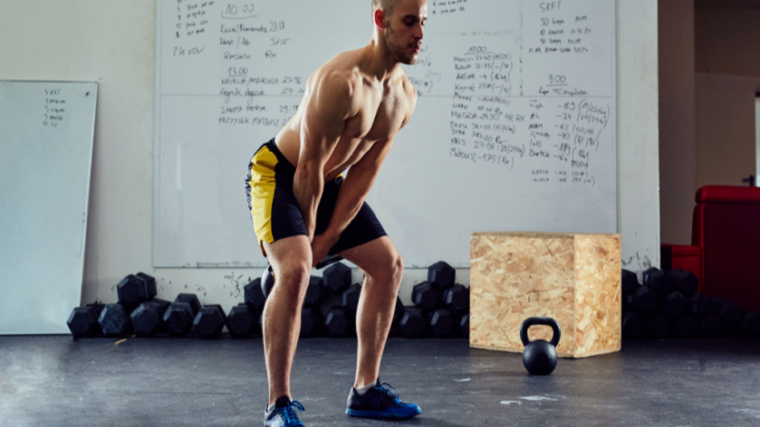
Flex your lats (back muscles) and forcefully pull the kettlebell back between your legs in a dynamic fashion while keeping your elbows slightly bent. Try to feel tension in your hamstrings and glutes as they stretch in the hinged position.
Keep your torso bent forward. Allow the weight to reach behind your legs. At its farthest position, the weight should be under or past your glutes.
Form tip: The kettlebell swing is a hinge, not a squat. There should be more horizontal movement than vertical. Done properly, the exercise recruits your posterior chain (glutes, hamstrings, and lower back) for maximal power.
Step 3 — Drive Up Explosively

Simultaneously contract your glutes while extending your hips and knees to drive the weight forward and up. Maintain straight or slightly bent arms throughout the rep. In the top position, your body should be straight and tall, with the weight stopping naturally around shoulder-level or slightly below.
Grip the weight hard, brace your core, and flex your quads to maintain balance and control at the top of the movement. Don’t allow the weight to pull you forward.
Form tip: The weight should be lifted by the driving force of your glutes and hips, not by actively lifting with your arms. Think of your arms as “ropes” holding the kettlebell — they are mainly used to guide the weight on its path upwards, not to assist the lift.
Step 4 — Allow the Weight to “Fall” Under Control
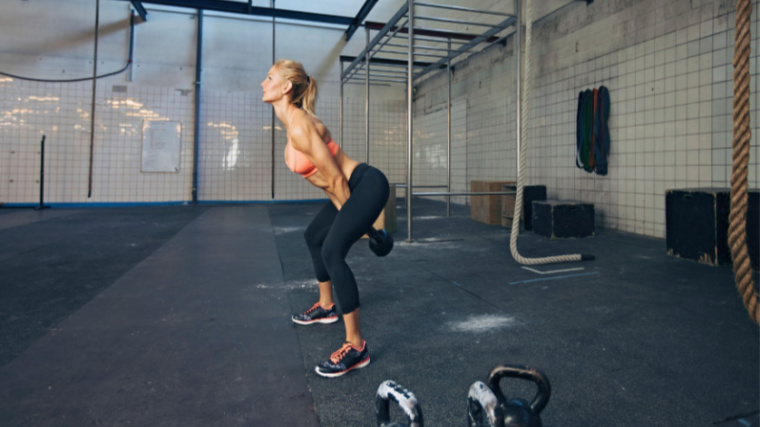
Let gravity do the work and allow the kettlebell to return to its position behind your legs. Keep your arms loose and your grip tight. Maintain a neutral spine as you hinge forward while the weight is falling. The weight should end up near your glutes.
From this stretched position, you can transition into the next repetition by repeating step three and using the momentum accumulated during the fall of the kettlebell.
Form tip: Be sure to hinge with a neutral spine as the weight returns to the bottom position, as this will properly load the powerful target muscles. Do not squat down because stress will shift to your shoulders, arms, and quadriceps.
Kettlebell Swing Mistakes to Avoid
This movement requires a cocktail of speed, balance, and coordination, so it’s easy to make a mistake. Whether you’re experienced with swings or you’re a complete beginner, review these common problems to make sure you’re not doing them.
Squatting Instead of Hinging
Some people have difficulty separating “hinge at the hips” from “reach down and touch your toes.” Those are two very different movements. Some lifters are also naturally more dominant in the anterior chain (the quadriceps). When lifters’ hips move up and down rather than front to back, it negatively affects muscle recruitment.

This is a problem because “squatty swings” will not only shift the workload away from the hamstrings and glutes, but will also result in lifters using their relatively weaker arms and shoulders to elevate the kettlebell.
Avoid it: Do not be afraid of bending forward while keeping a neutral spine. Keep a slight bend in your knees and think of your hips moving horizontally and not vertically, like you’re trying to touch the wall behind you with your butt.
Overextending Your Lower Back
The swing naturally involves the lower back muscles because they help extend the hips, especially to achieve an upright standing position.
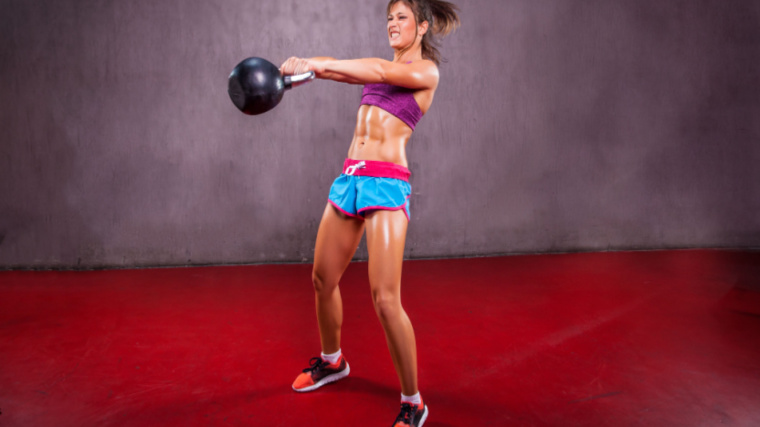
However, overextending at the top of the movement (leaning too far backwards when standing) puts a lot of unnecessary stress on your lower back. Your entire spine should remain neutral without any bending during the lift.
Avoid it: Squeeze your glutes as much as possible at the top of the movement. They are the prime moving muscle and focusing on their activation will prevent you from shifting the workload onto the lower back. Brace your core by flexing your abs as much as you can.
Driving Up With the Arms
When people pay too much attention to “lifting the kettlebell,” they sometimes start using their arms and shoulders before their hips have fully extended. This is a problem because it sacrifices lower body power. It also puts unnecessary stress on the shoulder joint by relying on smaller shoulder stabilizers instead of much stronger glute muscles.
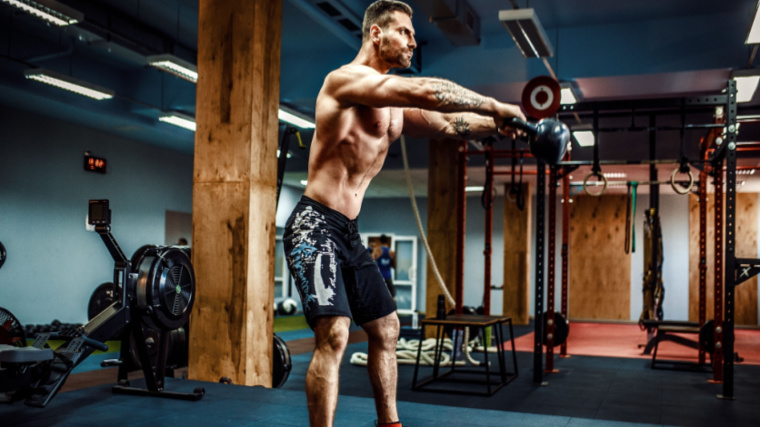
This issue can also occur when using lighter kettlebells which are “easier” to lift incorrectly (with the arms) or when people perform swings slowly, which defeats the purpose of the exercise because it’s always meant to be done explosively.
Avoid it: Make sure you are correctly performing an explosive hip hinge and properly engaging your glutes and hamstrings. Don’t over-focus on making sure the kettlebell reaches shoulder-level, let it occur naturally.
Benefits of the Kettlebell Swing
The kettlebell swing looks basic, maybe even “easy,” but this straight-forward movement packs a lot of benefits no matter what your goal is.
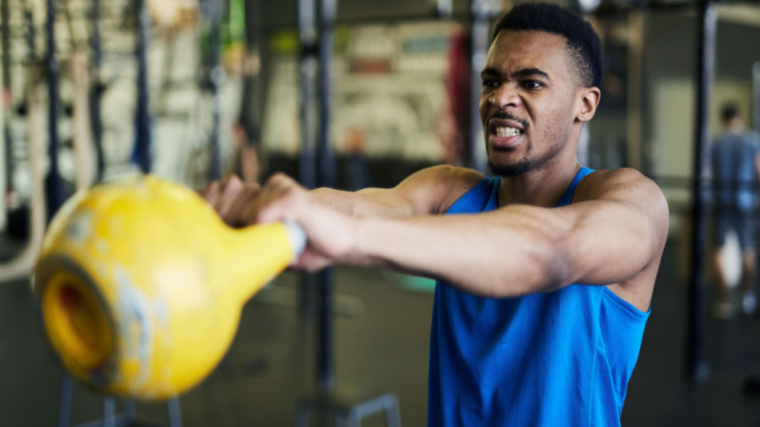
Whether you’re a performance-focused lifter, a competitive athlete, or looking to build your physique, the swing delivers results.
Explosive Power and Strength
Power is seen in sports when accelerating in a sprint, jumping, and throwing implements. Many types of athletic movements involve a hip hinge, which is optimized by training the swing. Swings also improve the explosive power of your lower body muscles. (1)
The swing has also been shown to be as effective at building strength as other training methods. (2) Sure, you use less weight than with a deadlift or a squat, but the dynamic performance of the swing improves intermuscular connection, continuous muscular recruitment and acceleration, as well as contraction speed. All of those factors help your nervous system become more efficient at using your muscles, so you end up becoming stronger.
Conditioning and Fat Loss
This exercise can be an efficient tool for improving cardio-respiratory fitness and has been shown to be as effective as other types of cardio exercise. (3) Because the kettlebell swing must be done explosively and cannot be performed at a low intensity, it is best used as part of a training circuit or for HIIT (high-intensity interval training). Swings are also very low impact and won’t irritate your knees when done properly.
Muscle Mass
The swing is not the first exercise that pops in our head when we think of hypertrophy, but its explosive nature — meaning great muscle recruitment — coupled with the potentially long time under tension make it a good candidate for building muscle mass. If you want to maximize hypertrophy, make sure to gradually increase the weight you use over weeks and months, but don’t go too heavy or you’ll lose the explosive mechanics.(4)
Grip Strength
The handles of most kettlebells are relatively thick and sometimes smooth, both of which challenge your grip strength as you apply explosive movement to the weight. A good swing workout may leave your forearms sore temporarily, but you will eventually develop a stronger grip and more muscular arms.
Muscles Worked By the Kettlebell Swing
The swing is a complete exercise that will recruit nearly every muscle in your body in some capacity. Nevertheless, its main objective is to improve the posterior chain.

Proper swings require strong contractions of your glutes, hamstrings, and core throughout each repetition.
Glutes
Like any hip hinge, the glutes are heavily involved in the swing. The gluteus maximus, medius, and minimus are a group of three large muscles that govern hip movement. In the swing, their main role is to extend the hips — bring the body from a bent-over position to an upright posture.
Try to squeeze your glutes as much as possible at the top of each repetition. This will shift the workload away from your lower back, promote maximal hypertrophy, and allow maximum power output.
Hamstrings
Your hamstrings are a series of posterior muscles that flex or bend the knees. The hamstrings also help extend the hips in conjunction with the glutes. In the swing, your hamstrings assist the glutes in driving the weight up from the bottom position by extending the hips.
If you have trouble feeling your hamstrings working during the exercise, focus on driving through your heels when raising the weight. Shifting onto your toes can reduce your hamstring recruitment.
Erector Spinae
Sometimes called the spinal erectors, this is considered the “lower back,” when it’s actually a length of muscle that goes from the pelvis up to the base of the skull. This postural muscle helps keep the spine in place and also contributes to hip extension. It will work a lot to stabilize your upper body in the swing.
If your back rounds over during the swing, you put the erector spinae into a more active role and increase the risk of injury. You don’t want to use them as the exercise’s prime mover.
Abdominals
The abdominals work together with the erector spinae to form the “core” and provide a stable upper body. The abs control torso rotation and flexion (bending forward), as well as resisting extension (leaning backward).
During the swing, your abs are highly active to maintain a neutral spine position, particularly in the bottom position when the weight pulls back between your legs. If your abs aren’t fully engaged, you’re more likely to follow the weight back, down, and through your legs.
Back
Even though you’re not pulling with your upper body, the other back muscles contribute to the lift. The latissimus dorsi (lats), the biggest back muscle, will be engaged to ensure spinal stability and maintain a strong arm position.
Across your upper back, the traps, rhomboids, and rear deltoids all work in conjunction to protect your shoulder joints and guide the kettlebell along its path.
Forearms
Your forearm muscles (wrist flexors and wrist extensors) are responsible for your grip strength, which is a big part of the kettlebell swing. Kettlebells typically have thicker handles than barbells or dumbbells, which challenges the grip more significantly.
The explosive nature of the swing also requires a strong grip to control the weight in the top position and prevent the kettlebell from flying away like the “cannonball with a handle” it appears to be.
Who Should Do the Kettlebell Swing
Anyone can do this exercise as long as they can perform it correctly — which is the vast majority of lifters. If you want to get stronger, more fit, and more muscular, find room in your program for the swing.
Functional Fitness Fans
Whether you’re a CrossFit athlete or someone that wants to be a jack of all trades, the kettlebell swing is a great addition to build several physical qualities at the same time. It will improve total-body strength, grip strength, power, conditioning, and build some muscle as well.
The swing is a great tool for people that need variety in their training because it can be programmed in many different ways. It can also be done virtually anywhere and any time, so if you just want to squeeze in a quick workout, swings are the perfect fix.
Strength Athletes
Competitive powerlifters and strongmen/strongwomen can benefit from an improved conditioning and recovery, as well as increased power and strength. The swing trains the hip hinge pattern, which carries over to many competitive events and builds stronger, more explosive hips.
Strength athletes don’t need to be able to run for miles, but withstanding a minute-long set or having improved conditioning to better recover between sets will certainly help in their training.
Beginners
If you’ve just started your fitness journey, the kettlebell swing is a great tool to practice and master the hip hinge, which carries over to countless exercises. The swing is also an efficient way to pack muscle onto your frame, while increasing your strength, power, conditioning, and coordination — all at the same time.
Endurance Athletes
Contrary to popular belief, endurance athletes have to do more than just running, biking, or swimming if they want to perform well and remain injury-free. The swing is a great strength exercise for endurance athletes, like marathon runners or triathletes.
The swing requires posterior chain mobility and strength, which is key to being comfortable in power positions on a bike. It is also a great exercise to recruit and develop the glutes for a more balanced physique, as runners and cyclists often have anterior chain (quadriceps) dominance which puts them at risk for knee pain.
How to Program the Kettlebell Swing
Because it is a dynamic power movement, you cannot go too heavy with the swing or you change the mechanics of the exercise. With excessively heavy weights, the range of motion is compromised and the weight can’t be accelerated as quickly. It is best used with moderate-to-high rep schemes.
Heavy Weight, Moderate Repetitions
This is the best rep range if you want to focus on a balance of strength and size. Three to five sets of five to 10 repetitions, close to technical failure, will do the trick.
Keep in mind that “heavy weight” doesn’t mean super-heavy. You still have to be able to accelerate the kettlebell with speed. If your range of motion becomes limited, you’ve gone too heavy.
Moderate Weight, Moderate Repetitions
This approach focuses on speed and explosive power. Five to eight sets of five to 10 repetitions is an excellent scheme for power, but you must avoid muscular failure at all costs.
You want to be exert maximum speed with each rep — the last rep of the set should feel as quick and snappy as the first. Use relatively lighter weights and keep some gas in the tank.
Moderate-to-Light Weight, High Repetitions
This type of plan is for those who really want to improve conditioning. And, if you approach failure, you can trigger some muscle growth as well. Begin with three to five sets of 10 to 30 repetitions.
Eventually, get crazy with much higher reps or even train for time instead of repetitions. For instance, do five sets of maximum repetitions in one minute. One effective way to train for time is to use an equal work-to-rest ratio. If you perform reps for one minute, take one minute rest between sets. Or 30 seconds on, 30 seconds off, etc.
The 10,000 Swing Workout
If you want a challenge well-beyond your comfort zone, try the 10,000 swing workout. Created by legendary strength and conditioning coach Dan John, this four-week plan will make you leaner, stronger, more muscular, and a generally tougher human.
Each training day will have you do 500 swings as well as a basic strength exercise. It follows a “two days on, one day off” schedule throughout the week, which ends up at a total of 10,000 swings spread across four weeks. Every workout, perform a total of 500 swings with this plan:
- Set 1: 10 reps
- Set 2: 15 reps
- Set 3: 25 reps
- Set 4: 50 reps
That’s 100 total swings in a round. Repeat four more times for a total of 500 swings per workout. Rest 30 to 60 seconds between sets and up to three minutes between rounds.
One strength exercise is performed after each set of swings using low repetitions and relatively heavy weight. Perform three sets using a 1, 2, 3 or 2, 3, 5 repetition scheme with basic, multi-joint exercises like the overhead press, dip, goblet squat, or chin-up. Single-joint exercises like curls or chest flyes are relatively easier and aren’t as effective. So one full round of the workout could look like:
- Set 1: 10 swings, 1 press, rest 30 seconds.
- Set 2: 15 swings, 2 presses, rest 30 seconds.
- Set 3: 25 swings, 3 presses, rest 60 seconds.
- Set 4: 50 swings, rest three minutes.
The recommended weight is a 24-kilogram (53-pound) kettlebell for men and a 16-kilogram (35-pound) kettlebell for women. For progression, push yourself to complete the workout faster each week instead of adding reps or using heavier weight.
Kettlebell Swing Variations
There are several ways to tweak the swing to focus on certain benefits of the lift. When you feel like the traditional swing has no secrets for you anymore, try one of these variations.
Double Kettlebell Swing
This is pretty much a standard swing, except that you hold a kettlebell in each hand. You might need to widen your stance a little bit to remain safe when the weights pass between your legs. If you want to train heavy but don’t have access to heavy kettlebells, this is the way to go.
This exercise is a great tool for strength development and grip training because you can go twice as heavy. It also requires more core and back bracing power to stabilize each shoulder and arm because the pair of weights are moving independently.
Banded Kettlebell Swing
As the name implies, this variation requires a resistance band. Loop it around the kettlebell and secure the ends under your feet to form a triangle. The added resistance of the band requires you to drive harder through your hips to build the speed and power needed to get the weight near chest-level.
It’s also a good way to induce more hypertrophy because the band actually pulls the kettlebell back during the descent, resulting in an accentuated eccentric phase (when the weight comes down). This eccentric stress can result in more muscular hypertrophy, especially in the hamstrings, which are a muscle group particularly receptive to eccentric contractions. (5)(6)
Single-Arm Kettlebell Swing
By holding the kettlebell in only one hand, you add a unilateral component to the exercise. This forces the back, shoulder, and arm to work more on the side that is holding the weight. The single weight requires your body to fight against rotation and flexing to the side.
This is a great movement for targeting your core and lower back stability. The single-sided challenge also recruits the oblique muscles of your core.
Kettlebell Swing Alternatives
If you don’t have a kettlebell, you can still train your explosive hip hinging and work your posterior chain. Here are some kettlebell-free alternatives.
Dumbbell Swing
Sometimes you really want to swing, but there are no kettlebells. Just grab a solid dumbbell by the head and start swinging. Be careful because the weight distribution of the dumbbell is different and its head is more awkward to grab since you’ll be using your fingers more than your entire hand.
Instead, tou could use both hands to hold the handle of the dumbbell. The weight will be more evenly balanced, compared to a kettlebell’s center of gravity being farther from your hands, which makes the exercise relatively easier. This method may be uncomfortable if the dumbbell handle is too small to fit both hands.
Broad Jump
Nothing beats the simplicity of bodyweight plyometrics for developing power and speed. You don’t even need equipment. With the broad jump, be sure to emphasize a forward jump for distance, not an upward jump for height.
When you perform this exercise, think about rep quality, not quantity. Keep your repetitions low and your rest periods long, so that each series is pristine.
Romanian Deadlift
This leg exercise is a staple for developing size and strength in the glutes, hamstrings, and back. Performing it with heavy-to-moderate weights for low-to moderate repetitions is an excellent substitution for the swing.
To take the power-building up another notch, loop a resistance band around the barbell and anchor it with your feet. Perform each repetition with maximal speed and avoid reaching muscular fatigue. This type of band training develops the speed component even more. (7)
FAQs
I worry about the kettlebell hitting between my legs and doing some serious damage. Any advice?
The key is to make sure that your hips are driving the movement. Lifting with your back might cause your spine to be hyperextended, which will cause the kettlebell to end up higher on your thighs.
Maintain a neutral back and don’t be afraid of bending forward at the hips to let the weight go behind you. At the lowest point of the swing, your forearms should be in contact with your inner thighs. Use this cue to swing safely.
What weight should I use?
When learning any new exercise, you should always use a light weight so that you get the feel of the exercise and develop proper technique. As a dynamic exercise, swinging a kettlebell that is too light won’t allow that proper exertion of force and power production. It’s one reason why you can’t throw a snowball as far as you can throw a baseball.
If you’re a beginner, aim to start with around 10% of your one-rep max deadlift. When you feel you have mastered the exercise and can do 15 good repetitions with perfect form, you can try going heavier.
Is it normal that my lower back hurts when doing kettlebell swings?
Back pain is not normal. Some back soreness, however, should be expected due to the stretched position and explosive movement. Soreness should dissipate in a matter of days, while serious pain can last longer. Soreness is typically dull, while pain can be felt in sharp bursts from sudden movements.
If you’re sure you have pain and not muscle soreness, double-check that your form is pristine and then check with a medical practitioner for any underlying condition. Otherwise, it could be because of a simple technical flaw. Hyperextending your back at the top will result in more stress on the lumbar spine.
The same is true if you lead with your back coming out of the bottom stretch, which uses your erectors as prime movers instead of as core-bracers. You have to ensure a proper hip hinge by squeezing your glutes as much as possible and keeping a flat back. Think of the lower back as a “bracing” muscle to keep your upper body stable.
Got Bell, Must Swing
The kettlebell swing isn’t just one of the most fundamental and generally useful kettlebell exercises. It’s one of the most fundamental and generally useful exercises of all time. You certainly don’t need to be a kettlebell specialist or compete in any strength sport to benefit from the swing, it delivers benefits for any lifter. Find a place in your training plan, program it properly, and start building a powerful posterior.
References
- Lake, Jason P.; Lauder, Mike A. Kettlebell Swing Training Improves Maximal and Explosive Strength, Journal of Strength and Conditioning Research: August 2012 – Volume 26 – Issue 8 – p 2228-2233doi: 10.1519/JSC.0b013e31825c2c9b
- Maulit, Matthew & Archer, David & Leyva, Whitney & Munger, Cameron & Wong, Megan & Brown, Lee & Coburn, Jared & Galpin, Andrew. (2017). Effects of Kettlebell Swing vs. Explosive Deadlift Training on Strength and Power. International Journal of Kinesiology and Sports Science. 5. 1-7. 10.7575/aiac.ijkss.v.5n.1p.1.
- Hulsey CR, Soto DT, Koch AJ, Mayhew JL. Comparison of kettlebell swings and treadmill running at equivalent rating of perceived exertion values. J Strength Cond Res. 2012 May;26(5):1203-7. doi: 10.1519/JSC.0b013e3182510629. PMID: 22395274.
- Rønnestad BR, Egeland W, Kvamme NH, Refsnes PE, Kadi F, Raastad T. Dissimilar effects of one- and three-set strength training on strength and muscle mass gains in upper and lower body in untrained subjects. J Strength Cond Res. 2007 Feb;21(1):157-63. doi: 10.1519/00124278-200702000-00028. PMID: 17313291.
- Schoenfeld BJ, Ogborn DI, Vigotsky AD, Franchi MV, Krieger JW. Hypertrophic Effects of Concentric vs. Eccentric Muscle Actions: A Systematic Review and Meta-analysis. J Strength Cond Res. 2017 Sep;31(9):2599-2608. doi: 10.1519/JSC.0000000000001983. PMID: 28486337.
- Kaminski TW, Wabbersen CV, Murphy RM. Concentric versus enhanced eccentric hamstring strength training: clinical implications. J Athl Train. 1998 Jul;33(3):216-21. PMID: 16558513; PMCID: PMC1320426.
- Ataee J, Koozehchian MS, Kreider RB, Zuo L. Effectiveness of accommodation and constant resistance training on maximal strength and power in trained athletes. PeerJ. 2014 Jun 17;2:e441. doi: 10.7717/peerj.441. PMID: 25024910; PMCID: PMC4081144.
Featured Image: SeventyFour / Shutterstock
The post How to Do the Kettlebell Swing for Explosive Power, Strength, and Conditioning appeared first on Breaking Muscle.
Filed under: Fitness

 For now classes are 6pm and 640pm at 2840 Wildwood st in the Boise Cloggers studio.
Book your class NOW!
click this ==>
For now classes are 6pm and 640pm at 2840 Wildwood st in the Boise Cloggers studio.
Book your class NOW!
click this ==>








